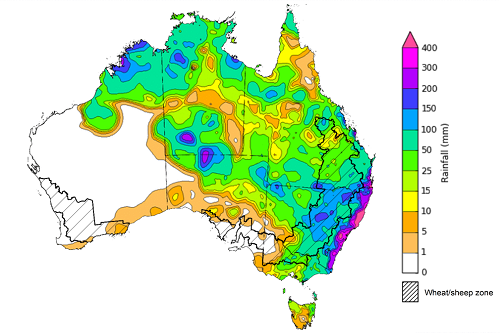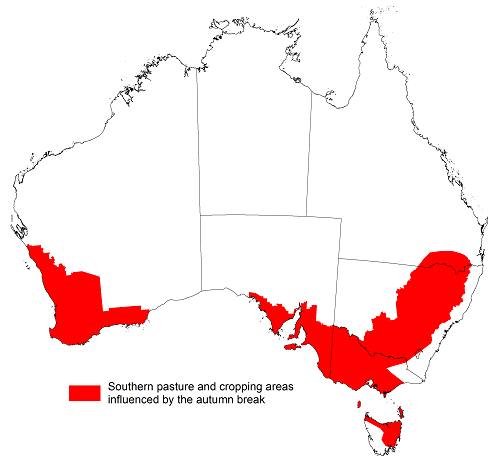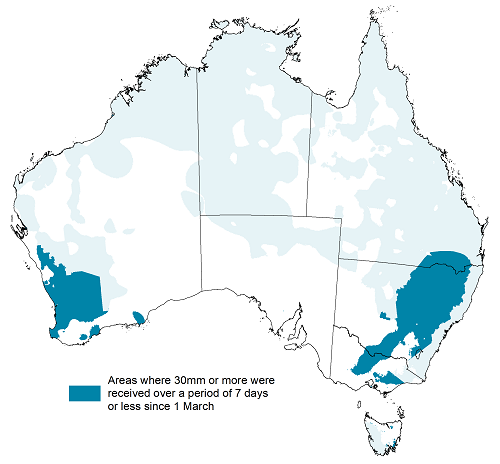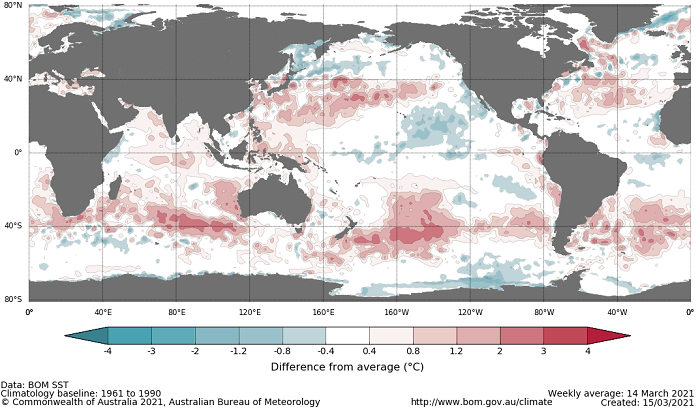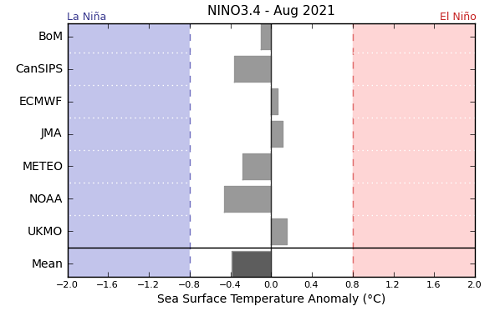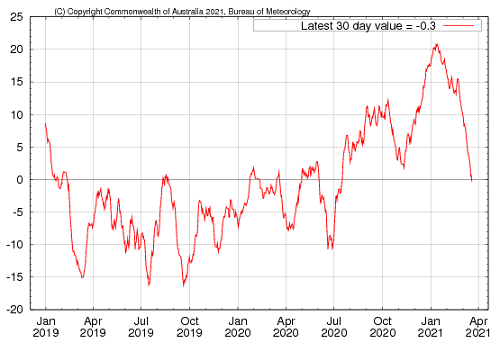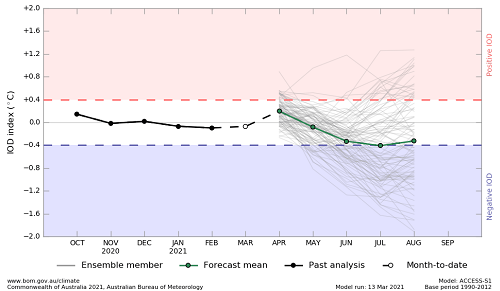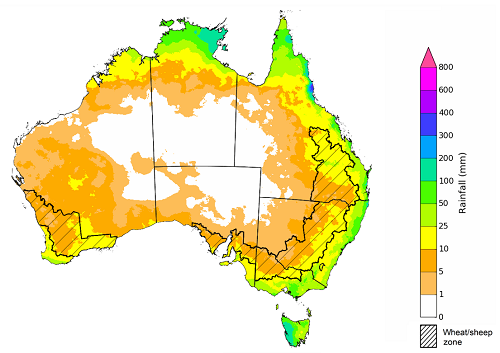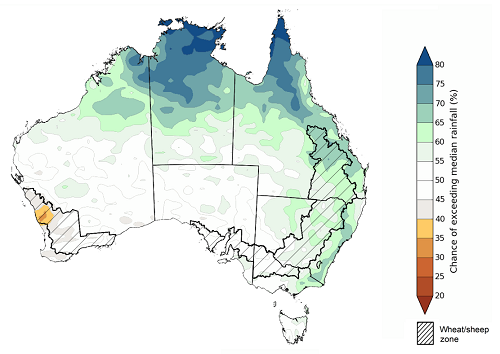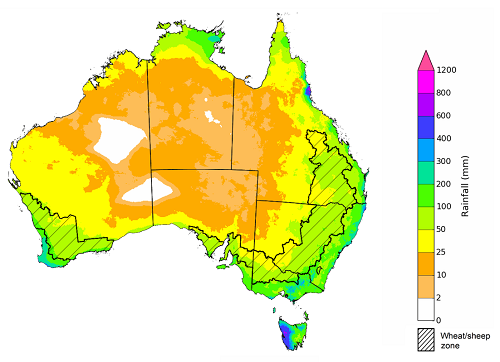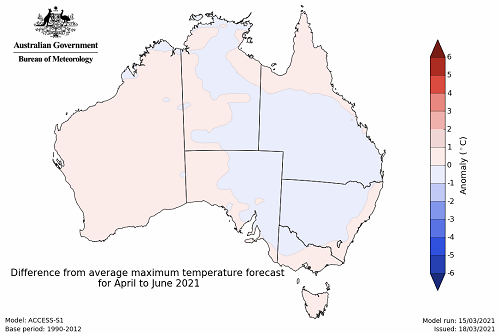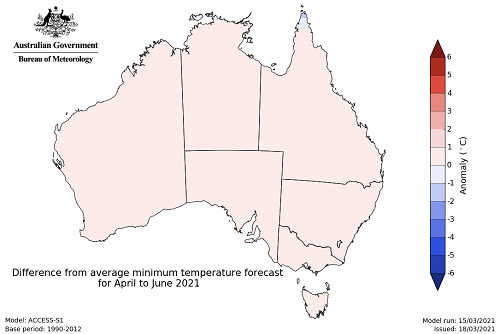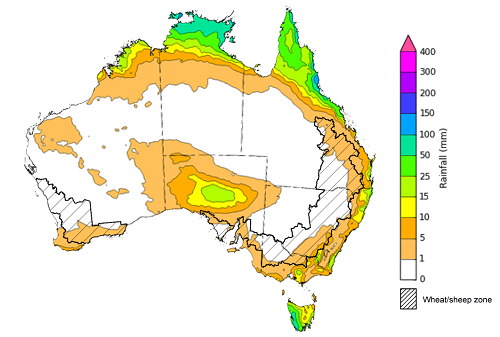Key issues
- During the 7 days to 24 March 2021, troughs and low-pressure systems generated thunderstorms and showers across eastern, central and northern Australia, with large areas recording weekly rainfall totals in excess of four times their March average.
- The heavy rainfall across eastern Australia this week led to widespread flood warnings and record-breaking flood peaks in some areas. This flooding has disrupted some agricultural activities and caused severe localised damage to infrastructure and is likely to have resulted in some loss of livestock and crops. In contrast, the rainfall associated with this event will provide a substantial boost to soil moisture and water storages, benefitting future winter and summer crop production and pasture growth.
- ABARES analysis of daily rainfall data sourced from the Bureau of Meteorology indicates that an early autumn break has been achieved across much of New South Wales and Queensland, parts of central and eastern Victoria and large areas of Western Australia.
- Atmospheric and oceanic indicators continue to suggest the La Niña event is drawing to a close. Favourable production conditions associated with the La Niña are likely to persist through autumn as the La Niña event weakens.
- There is a 50% chance of recording average or better April to June rainfall across most winter cropping regions. Given the average or better soil moisture levels across cropping regions in much of New South Wales, South Australia and Western Australia, these falls will likely support at least average pasture growth and the planting of winter crops.
- Over the next 8 days, troughs, onshore winds and cold fronts are expected to generate showers and storms over parts of northern, eastern and southern Australia.
- In Australia’s cropping regions, rainfall of between 1 and 10 millimetres is expected for parts of south-eastern New South Wales, northern and eastern Queensland, southern Victoria, South Australia and southern Western Australia over the next 8 days. Following an early autumn break across most winter cropping regions in western and eastern Australia, these low rainfall totals will likely allow farmers to begin sowing winter forage crops.
- Water storage levels in the Murray-Darling Basin (MDB) increased by 177 gigalitres (GL) between 17 March 2021 and 24 March 2021. The current volume of water held in storage is 13,041 GL, which represents 52% of total capacity.
- Allocation prices in the Victorian Murray below the Barmah Choke decreased from $100 per ML on 18 March 2021 to $69 per ML on 25 March 2021. Prices are lower in the Murrumbidgee due to the binding of the Murrumbidgee export limit.
Climate
[expand all]
Rainfall this week
During the week ending 24 March 2021, troughs and low-pressure systems generated thunderstorms and showers across parts of eastern, central and northern Australia.
Rainfall totals of between 25 and 100 millimetres were recorded across much of New South Wales, Queensland and the Northern Territory, and parts of eastern and central Victoria, northern South Australia, northern Western Australia and north-eastern Tasmania. Rainfall in excess of 100 millimetres was recorded across much of central and eastern New South Wales and parts of southern Queensland, central Australia, northern Western Australia and the north of the Northern Territory. Rainfall in excess of 200 millimetres was recorded across the eastern coast of New South Wales and far south-eastern Queensland, with rainfall totals greater than 400 millimetres across parts of the central New South Wales coast.
In Australia’s cropping regions, rainfall totals of between 25 and 100 millimetres were recorded across much of Queensland and parts of south-western New South Wales and eastern Victoria. Rainfall totals between 100 and 200 millimetres were recorded in cropping regions across much of central and northern New South Wales and parts of southern Queensland. Little to no rainfall was recorded across cropping regions in South Australia and Western Australia.
The heavy rainfall across eastern Australia this week led to widespread flood warnings and record-breaking flood peaks in some areas. This flooding has disrupted some agricultural activities and caused severe localised damage to infrastructure and is likely to have resulted in some loss of livestock and crops. In contrast, the rainfall associated with this event will provide a substantial boost to soil moisture and water storages, benefitting future winter and summer crop production and pasture growth.
Rainfall for the week ending 24 March 2021
©Commonwealth of Australia 2021, Australian Bureau of Meteorology - Issued: 24/03/2021
Note: The rainfall analyses and associated maps utilise data contained in the Bureau of Meteorology climate database, the Australian Data Archive for Meteorology (ADAM). The analyses are initially produced automatically from real-time data with limited quality control. They are intended to provide a general overview of rainfall across Australia as quickly as possible after the observations are received. For further information go to http://www.bom.gov.au/climate/rainfall/
Early autumn break
In southern Australia, the timing of the autumn break is an important ingredient for a successful pasture and crop production season. The autumn break is the first significant rainfall of the winter growing season and provides enough moisture to initiate crop and pasture germination and support early plant growth. The break generally applies to the southern pasture and cropping areas mainly in New South Wales, Victoria, South Australia, Western Australia and Tasmania — and occasionally parts of southern Queensland.
Areas likely to be influenced by the autumn break
Source: ABARES
As at 28 February 2021 global production conditions were generally favourable. A lack of precipitation and temperature extremes have affected the production potential of wheat, corn, rice and soy in some key grain exporters and importers.
An early autumn break can increase the length of the growing season, potentially improving production and yield. The definition of the autumn break in southern Australia varies. Pook et al. (2009) suggested an ideal break for north-western Victoria occurs during March–June when a mean fall of 25 millimetres or more is recorded over a period of 3 days or less, or when a mean fall of 30 millimetres or more is recorded over a period of 7 days or less.
Areas that have achieved 30 millimetres in any 7‐day period from 1 March to 22 March 2021
Source: Bureau of Meteorology, ABARES
ABARES has adapted the Pook et al. (2009) autumn break definition of falls of 30 millimetres or more recorded within any 7-day period from 1 March to identify where the autumn break threshold has been achieved across southern Australia. ABARES analysis of daily rainfall data sourced from the Bureau of Meteorology indicates that the autumn break has been achieved across much of New South Wales and Queensland, parts of central and eastern Victoria and large areas of Western Australia.
Typically, the autumn break is driven by westerly fronts moving across southern Australia and cut-off low pressure systems. This uncharacteristic early autumn break in south-eastern Australia has been driven by incursions of moist tropical air from northern Australia resulting in substantial rainfall.
Climate Drivers
With the summer cropping and northern pasture production season drawing to a close, the focus shifts to likely conditions for autumn and the start of the winter cropping season. To gain some insight, it is important to look at the climate drivers—the El Niño–Southern Oscillation (ENSO), the Indian Ocean Dipole (IOD) and the Madden–Julian Oscillation (MJO)—that can influence autumn and early winter rainfall across Australia.
The La Niña event that has influenced Australia’s climate over the past several months may be drawing to a close as oceanic indicators suggest a return to neutral conditions. While the La Niña event has brought favourable growing conditions for summer crops and pasture production across northern and eastern Australia, a return to neutral conditions reduces the influence ENSO has on Australian weather patterns. The favourable growing conditions resulting from the La Niña event were central in developing ABARES summer crop and livestock production forecasts embodied in the ABARES March 2021 edition of the Agricultural commodities and February 2021 edition of the Australian crop report. The favourable production conditions, with above average rainfall, are likely to persist through autumn as the La Niña event weakens.
Sea surface temperature anomalies across much of the tropical Pacific Ocean have weakened over the past two weeks. The below average temperatures had remained steady over the preceding months, but have largely seen a return to the long-term average. Warm sea surface temperature anomalies in the waters near Western Australia have strengthened considerably and warm anomalies remain in the waters near Indonesia and the Philippines. As at 16 March 2021 all of the international climate models surveyed are expecting sea surface temperature across the tropical Pacific Ocean to return to neutral ENSO values by May and remain neutral until at least August.
Difference from average sea surface temperature observations 8 March to 14 March 2021
International climate model outlooks for the NINO 3.4 region in August 2021
©Commonwealth of Australia 2021, Australian Bureau of Meteorology - Issued: 16/03/2021
Atmospheric indicators suggest an easing of the La Niña event and a potential return to neutral conditions. Trade wind strength has decreased over the past couple of weeks, but remains above average, while cloudiness near the Date Line remains below average. For the period ending 21 March the 30‑day Southern Oscillation Index (SOI) value was -0.3 and for the period ending 14 March the 90‑day value was 13.1. The SOI values have been declining since January. The 30-day SOI has dropped below the La Niña threshold value of +7, while the 90-day SOI has trended down but remains above the threshold. The SOI values indicate a likely return to neutral conditions.
30-day Southern Oscillation Index (SOI) values ending 21 March 2021
As at 23 March 2021 the Madden-Julian Oscillation (MJO) is weak and currently located away from the Australian region. However, climate models predict the MJO will strengthen and move to the north of Australia near the end of March. The MJO is a pulse of cloud and rainfall that moves eastward along the equator. The presence of the MJO north of Australia is likely to result in above average cloudiness and rainfall across northern Australia.
Madden–Julian Oscillation (MJO) daily index
Note: This map displays the forecast outgoing longwave radiation (OLR) difference from expected cloudiness to identify convective rain clouds and the position of the Madden–Julian Oscillation (MJO). The blue shading indicates higher than normal, active or enhanced tropical weather and the brown shading indicates lower than normal clouds or suppressed conditions.
Sea surface temperatures across the Indian Ocean have been warmer than average, with a warm body of water off Western Australia potentially influencing local weather conditions. The Indian Ocean Dipole (IOD) is currently neutral with the potential to reach the negative IOD threshold (-0.4) by July. IOD values at or below -0.4 must be sustained for eight weeks for this to be considered a negative IOD event. Three of the five international models surveyed are expected to reach or exceed negative IOD thresholds by July; however, accuracy of the models at this time of year is lower than at other times. A negative IOD is associated with above average winter and spring rainfall across southern Australia, as well as the far north. It is also associated with an early northern rainfall onset.
Monthly sea surface temperature anomalies for IOD region
National Climate Outlook
These climate outlooks are generated by ACCESS–S (Australian Community Climate Earth-System Simulator–Seasonal). ACCESS–S is the Bureau of Meteorology's dynamical (physics-based) weather and climate model used for monthly, seasonal and longer-lead climate outlooks.
For further information, go to http://www.bom.gov.au/climate/ahead/about/
The latest rainfall outlook released by the Bureau of Meteorology suggests that wetter than average conditions are more likely for parts of northern and eastern Australia during April 2021, consistent with the continuing influence of the weakening La Niña event.
The outlook for April 2021 indicates that there is a 75% chance of rainfall totals between 10 and 100 millimetres across parts of the eastern coast of Australia, southern Victoria, south-western Western Australia, eastern Tasmania and far northern Australia. Rainfall totals in excess of 100 millimetres are expected across isolated parts of north-eastern Queensland, the far north of the Northern Territory and western Tasmania.
Across cropping regions there is a 75% chance of rainfall totals between 5 and 10 millimetres in parts of western New South Wales, southern Queensland, northern Victoria, western and central Western Australian cropping regions and most South Australian cropping regions. There is a 75% chance of rainfall totals between 10 and 25 millimetres across cropping regions in parts of eastern New South Wales, central and northern Queensland, southern Victoria, far southern South Australia and eastern Western Australian cropping regions.
The ACCESS-S climate model suggests there is a 50% chance of recording average or better April rainfall totals across most of Australia, including the major cropping regions. This would suggest that it is less likely that cropping regions in western Victoria and South Australia would experience a repeat of last season’s early autumn break in April which facilitated widespread planting of winter crop under ideal sowing conditions.
Rainfall totals that have a 75% chance of occurring April 2021
©Commonwealth of Australia 2021, Australian Bureau of Meteorology - Issued: 18/03/2021
The rainfall outlook for April to June 2021 suggests there is a greater than 60% chance of above average rainfall across much of northern Australia and parts of eastern Australia. There is less than a 40% chance of exceeding median rainfall in isolated parts of south-western Western Australia (Bureau of Meteorology ‘National Climate Outlook’, 18 March 2021). Bureau of Meteorology rainfall outlooks for April to June have greater than 65% past accuracy across much of the eastern two-thirds of Australia. The outlooks have greater than 75% past accuracy for parts of southern and far northern Queensland, central South Australia, and north-western Western Australia and the north and south-east of the Northern Territory.
Chance of exceeding the median rainfall April to June 2021
©Commonwealth of Australia 2021, Australian Bureau of Meteorology - Issued: 18/03/2021
The outlook for April to June 2021 suggests there is a 75% chance of rainfall totals between 25 and 100 millimetres across much of eastern and south-western Australia and parts of far southern and far northern Australia. Rainfall totals in excess of 100 millimetres are likely across parts of eastern New South Wales, eastern Queensland, southern Victoria, south-eastern South Australia, south-western Western Australia, the north of the Northern Territory and Tasmania.
Across cropping regions, there is a 75% chance of receiving between 50 and 100 millimetres across most cropping regions. Lower totals of between 25 and 50 millimetres are expected across cropping regions in parts of south-western New South Wales, south-western and northern Queensland, northern Victoria, north-eastern South Australian cropping regions and central Western Australian cropping regions between April and June 2021.
There is a 50% chance of recording average or better April to June rainfall across most winter cropping regions. Given the average or better soil moisture levels across cropping regions in much of New South Wales, South Australia and Western Australia, these falls will likely support average or better pasture growth, as well as the planting of winter crops.
Rainfall totals that have a 75% chance of occurring April to June 2021
©Commonwealth of Australia 2021, Australian Bureau of Meteorology - Issued: 11/03/2021
The temperature outlook for April to June 2021 indicates that day-time and night-time temperatures across most of Australia are likely to be close to the 1990-2012 average (- 1°C to 1°C) (Bureau of Meteorology ‘National Climate Outlook’, 18 March 2021).
Predicted maximum temperature anomaly for April to June 2021
Predicted minimum temperature anomaly for April to June 2021
Rainfall forecast for the next eight days
Troughs, onshore winds and cold fronts are expected to generate showers and storms over parts of northern, eastern and southern Australia during the next 8 days.
Rainfall totals of between 10 and 25 millimetres are forecast for parts of eastern New South Wales, northern and eastern Queensland, eastern Victoria, central South Australia, northern Western Australia, the north of the Northern Territory and Tasmania. Rainfall totals in excess of 25 millimetres are forecast for parts of northern Australia and western Tasmania.
In Australia’s cropping regions, rainfall of between 1 and 10 millimetres is expected for parts of south-eastern New South Wales, northern and eastern Queensland, southern Victoria, South Australia and southern Western Australia. Following an early autumn break across most winter cropping regions in western and eastern Australia, these low rainfall totals will likely allow farmers to begin sowing winter forage crops.
Total forecast rainfall (mm) for the period 25 March to 1 April 2021
©Commonwealth of Australia 2021, Australian Bureau of Meteorology - Issued: 25/03/2021
Note: This rainfall forecast is produced from computer models. As the model outputs are not altered by weather forecasters, it is important to check local forecasts and warnings issued by the Bureau of Meteorology.
Water
Water storages, water markets and water allocations - current week
The Tableau dashboard may not meet accessibility requirements. For information about the contents of these dashboards contact ABARES.
Commodities
Information on weekly price changes in agricultural commodities is now available at the Weekly commodity price update.

